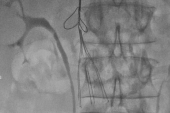IVC Filter Use Declining, but Retrieval Rates Abysmally Low: SAFE-IVC
(UPDATED) Just 15% of patients have their filters taken out despite clear recommendations they should be removed as soon as feasible.

Use of inferior vena cava (IVC) filters declined substantially over a recent 8-year period, and while retrieval rates went up in that time, just one in seven indwelling filters were retrieved in a timely manner after insertion, the large, observational SAFE-IVC study shows.
The number of IVC filter insertions among more than 270,000 Medicare fee-for-service beneficiaries decreased from 44,680 per year in 2013—an incidence of 157.8 insertions per 100,000 people—to 19,501, or 64.1 insertions per 100,000 people, in 2021.
The proportion of IVC filters taken out also increased from 2013 to 2021, but the number of extracted filters remained flat at roughly 4,000 per year, or 13.0 retrievals per 100,000 Medicare beneficiaries.
“The percent of retrievals went up—it went from 10% to 20%—and that sounds great, but it’s really just because the denominator is decreasing,” lead investigator Enrico Ferro, MD (Beth Israel Deaconess Medical Center, Boston, MA), told TCTMD. “The absolute number [of retrievals] is the same, which makes me think there is ultimately some sort of ceiling effect, meaning that with the current policy, broadly speaking, this is what we’re getting.”
Senior researcher Eric Secemsky, MD (Beth Israel Deaconess Medical Center), said that the issues related to long IVC filter dwell times have been known for a while. “Although us clinicians are becoming appropriately more selective with determining who is in need of an IVC filter, we still struggle with retrieval,” he told TCTMD.
IVC filters are used to prevent pulmonary embolism (PE) in patients with venous thromboembolism (VTE) and contraindications to anticoagulation, as well as those who have failed anticoagulation. In the US, it’s estimated that nearly 40,000 IVC filters are placed annually, with nearly one in six Medicare beneficiaries with PE receiving a filter.
In 2010 and 2014, the US Food and Drug Administration issued safety communications that advised physicians to remove IVC filters as soon as clinically feasible. The devices are meant to be taken out once the patient’s risk of PE subsides because there can be complications, such as filter fracture or device embolization, if they are left in place too long.
Riyaz Bashir, MD (Temple University Lewis Katz School of Medicine, Philadelphia, PA), who looked into temporal trends in IVC filter use following the 2010 FDA advisory, said that while filter use is declining in the US, these latest numbers are still too high.
“We’re still implanting far more IVC filters in the United States [than anywhere else], leading to substantial complication rates in patients who live long enough to have the filters in their body,” he told TCTMD. “With the healthcare system in this country, we need to be cognizant of not only the medical consequences of putting these filters in and not taking them out in a timely fashion, but you also need to be aware of the costs that are associated with putting these filters in and taking them out.”
The SAFE-IVC results were published online earlier this month in JAMA.
In an editorial, Behnood Bikdeli, MD (Brigham and Women’s Hospital/Harvard Medical School, Boston, MA), and Joseph Ross, MD (Yale School of Medicine, New Haven, CT), say the study provides “robust and reliable” estimates of IVC filter use and retrieval attempts, which were largely successful in the first few months after implantation.
Speaking with TCTMD, Bikdeli said the IVC filter retrieval rate among Medicare beneficiaries is “inexplicably and unacceptably” low.
"Assuming that IVC filters do work, more or less, you place a retrievable filter for a reason, and you should be able to retrieve them as soon as possible,” he said. “If you keep them in place, you are going to increase the rate of deep vein thrombosis, as these authors show, and as numerous other investigations have shown, and you’re going to increase the risk of filter-related complications.”
Study Done With FDA
Controversy has surrounded the use of IVC filters, in no small part because the devices are categorized as moderate-risk products and cleared through the FDA’s 510(k) process, for which devices only need to show “substantial equivalence” to a predicate.
Over the past decade, researchers have made the case that IVC filters are overused and that there is little in the way of randomized, controlled research testing their effectiveness. The trials that have been done show filters can reduce the risk of PE but may increase the risk of deep vein thrombosis (DVT). Some studies have suggested there may be a survival benefit when they are used for those at high risk for PE, while others have suggested use may be harmful.
The existing data, along with clinical guidelines, say the filters are safe to temporarily use in situations where there is an active contraindication to anticoagulation and an active risk for venous thromboembolism, said Ferro. “That’s the theory, but then nobody knew what was actually happening,” he said. “There were a lot of questions about something that’s incredibly commonly used.”
The SAFE-IVC study was conducted in collaboration with the FDA to investigate temporal trends and practice patterns of insertion and retrievals among older US adults. The investigators also wanted to assess the periprocedural and long-term safety events during the device’s lifecycle.
Out of the study’s 270,866 patients (mean age 75 years; 53% women), 14.9% had their device retrieved. More than 16,000 operators inserted the devices at 3,800 hospitals, and 8,500 operators took the filters out at 1,800 centers. Nearly 30% of patients had the device inserted and removed at different hospitals. A full 65% of patients received an IVC filter to treat first-time VTE, 26.3% for recurrent VTE, and 8.8% for VTE prophylaxis. Among those who received a filter, 63.3% had a major contraindication to anticoagulation, which included patients with recent major bleeding (50.8%) and major trauma (25.3%).
There is a small minority of physicians who are doing this right, because they are taking it out in a timely manner. Enrico Ferro
Older patients, those with major contraindications to anticoagulation, and those with comorbidities such as heart failure or malignancies were less likely to have the IVC filter removed. Black patients, those with dual enrollment in Medicare and Medicaid, and those living in distressed communities were also less likely to have the filter taken out. Those treated at a teaching or larger hospital were more likely to have the filter retrieved.
At 30 days, the composite safety outcome—defined as all-cause mortality, IVC filter-related complications, operating room (OR) visits following filter-related procedures, and new DVT diagnosis—occurred in 27.3% of patients who received a filter, with 14.6% dying and 9.6% requiring a periprocedural OR visit. Complications during implantation were low (0.3%).
For those who survived to retrieval, 93.5% had the devices successfully taken out and the 30-day safety event rate was low at 3.9%. The majority of filters were taken out within the first year (median time 0.3 years).
“There is a small minority of physicians who are doing this right, because they are taking it out in a timely manner,” said Ferro. “Within 3 months, clinically, it sounds to me like the patient had an issue and couldn’t take anticoagulation, so they received a filter. The physicians are then reminded to take it out and they took them out. That’s how it should be. When you do it correctly, the risk of extraction is low.”
For those with indwelling IVC filters, the median follow-up time was 1.2 years. Filter-related complications occurred in 1.4% of patients, caval thrombosis in 2.2%, a new diagnosis of DVT in 21.2%, and DVT requiring a hospital visit in 9.2%. After a maximum follow-up of 9 years, 81.0% of patients had died.
Multidisciplinary Care
The decline in the use of IVC filters over time suggests clinical practice is now more closely aligned with the clinical guidelines, said Ferro. The introduction of direct oral anticoagulants with lower risks of bleeding compared with warfarin has helped as its improved medical care and made physicians more comfortable using anticoagulation.
Regarding the low rate of retrievals, Ferro said it’s possible the fractionation of patient care—doctors placing IVC filters are not the same as those following the patient long-term—might be one reason why there’s been little improvement over time.
Bashir agreed.
“The physician who sees the patient as part of the [healthcare] group might not even remember that this patient had an IVC filter put in during the hospitalization,” he said. The breakdown in communication is exacerbated when patients are treated outside their home hospital and/or clinic, he added.
IVC filters are easy to place, said Bashir, and logically make sense: the patient is not going to have a catastrophic pulmonary embolism after the device placed in the IVC. “The difficulty is that this perception leads to overutilization of the device,” said Bashir. “The real treatment of blood clots is blood-thinning medication.”
For this reason, Bashir recommends a multidisciplinary team approach when it comes to decisions around placing a filter, emphasizing that use should be reserved for patients with active bleeding. This could help eliminate some of the reflexive choice to place a filter, especially in a patient without a clear contraindication to anticoagulation, he said. Additionally, hospitals should be publicly reporting their implantation and retrieval rates as part of quality-improvement efforts.
“At the height of it, we were implanting 25 or 35 times more IVC filters in the US than in Europe,” he said. “The great news is that numbers have gone down substantially, as this paper shows, but implantation rates are still very high.”
You place a retrievable filter for a reason, and you should be able to retrieve them as soon as possible. Behnood Bikdeli
Several years back, Bikdeli also looked into the use of IVC filters among Medicare patients hospitalized with PE.
“Nearly one in five of US older adults was getting an IVC filter,” he told TCTMD. “It was very troubling to me because other studies in Europe have shown that physicians are using IVC filters far less frequently and I can guarantee you that patients are not dying more from PE. Even though one-by-one case appropriateness is difficult to ascertain in these cases, it's not out of question that we’re overusing the technology.”
The researchers point out that single-center studies have shown retrieval rates can be increased with tracking systems, scheduled outpatient communications, and planned postdischarge vascular clinic visits. Computerized reminders also can help, as would initiatives such as Medicare’s merit-based payment system for appropriate assessment of IVC retrieval.
Regulatory Framework
In their editorial, Bikdeli and Ross point out that 90% of devices undergoing regulatory review are deemed moderate risk and approved via the 510(k) pathway. Postmarket surveillance is critical, though it remains challenging given the large number of complex devices, short product life cycles, and the learning curve associated with technology.
SAFE-IVC addresses important gaps in postmarket surveillance, but there are limitations to these data as well. For one, there are no data on patients in whom IVC filters may have been indicated, but who weren’t treated, which limits insights into the comparative effectiveness and safety of the devices for patients at risk for PE. Additionally, the investigators were unable to look into outcomes with specific IVC filters given the lack of unique device identifier (UDI) data. UDIs, they say, would allow researchers to conduct routine, long-term surveillance over a device’s life cycle.
Further efforts to improve postmarket surveillance are still needed, write Bikdeli and Ross, so that doctors have the best available evidence to guide decisions for filters and other devices.
To TCTMD, Secemsky said that as smaller hospitals are reorganized into larger healthcare systems that enable “harmonized electronic health records and increasing utility of artificial intelligence, we are positioned to tracking patients with IVC filter implants and assuring safe and timely removal.”
Michael O’Riordan is the Managing Editor for TCTMD. He completed his undergraduate degrees at Queen’s University in Kingston, ON, and…
Read Full BioSources
Ferro EG, Mackel JB, Kramer RD, et al. Postmarketing surveillance of inferior vena cava filters among US Medicare beneficiaries: the SAFE-IVC study. JAMA. 2024;Epub ahead of print.
Bikdeli B, Ross JS. Enhancing medical device postmarketing safety surveillance: the case of inferior vena cava filters. JAMA. 2024;Epub ahead of print.
Disclosures
- Ferro reports no relevant conflicts of interest.
- Outside the submitted work, Bikdeli reports being supported by a Career Development Award from the American Heart Association and VIVA Physicians, the Scott Schoen and Nancy Adams IGNITE award, the Mary Ann Tynan Research Scientist award from the Mary Horrigan Connors Center for Women’s Health and Gender Biology, and the Heart and Vascular Center Junior Faculty Award from Brigham and Women’s Hospital; previously serving as a consulting expert on behalf of the plaintiff for litigation related to two brand models of IVC filters (no involvement or compensation since 2022); being a member of the medical advisory board for the North American Thrombosis Forum; serving on the data and safety monitoring board of the NAIL-IT trial (funded by the National Heart, Lung, and Blood Institute [NHLBI] and Translational Sciences, Inc); acting as a collaborating consultant with the International Consulting Associates and the FDA in a study to generate knowledge about IVC filters; and receiving compensation as an Associate Editor for the New England Journal of Medicine Journal Watch Cardiology, Associate Editor for Thrombosis Research, Executive Associate Editor for Journal of the American College of Cardiology, and Section Editor for Thrombosis and Haemostasis (no compensation).
- Ross reports receiving grants from the FDA, Johnson & Johnson, the Medical Device Innovation Consortium, the Agency for Healthcare Research and Quality, the National Institutes of Health/NHLBI, and Arnold Ventures outside the submitted work; serving as an expert witness at the request of relator’s attorneys, Greene Law Firm, in a qui tam suit alleging violations of the False Claims Act and Anti-Kickback Statute against Biogen Inc settled in September 2022; and being a Deputy Editor of JAMA.
- Secemsky reports receiving grants from ICA Health, the FDA, BD, Cook Medical, and Philips, as well as personal fees from BD, Cook Medical, Philips, and Cordis outside the submitted work.





Comments